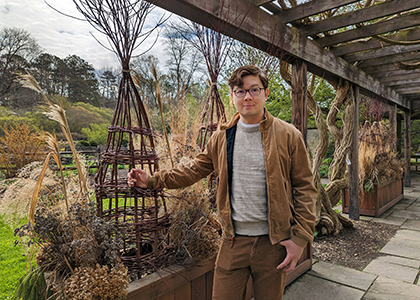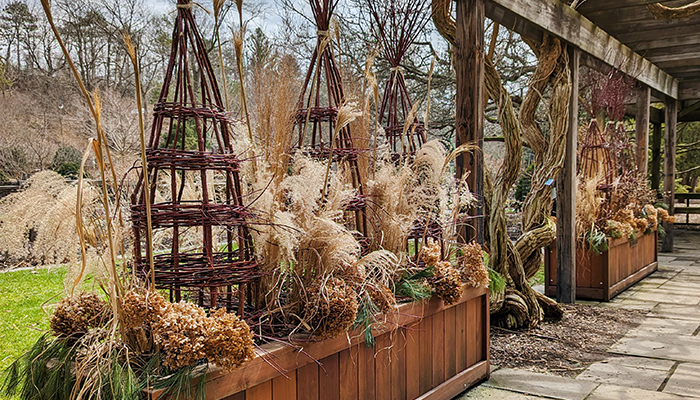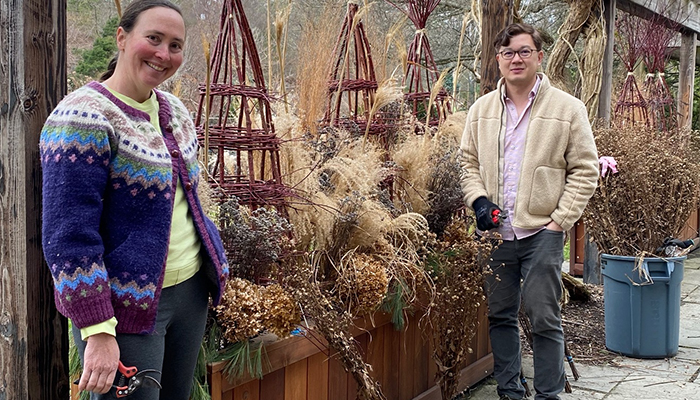
A master’s-degree student incorporated dormant and dried plant material collected from Cornell Botanic Gardens together with fragrant spring annuals in a display that added visual interest, color, and fragrance in the dormant months
A Sustainable Approach to Creating Winter and Early Spring Displays at Botanic Gardens
In late winter and early spring, visitors to Cornell Botanic Gardens encountered a display of structural obelisks woven from the canes of native Red Twig Dogwood juxtaposed with an array of ornamental seedheads of native plant species. These artistically arranged displays sat atop the planter boxes in the pergola along the Robison York State Herb Garden and comprised the capstone project for my master’s degree in the Public Garden Leadership program.

The goal of my project was to promote winter and early spring botanical displays for botanic gardens in the Northeast. I developed a protocol for creating displays to draw visitors to the gardens during the colder dormant months of the year and that also may inspire homeowners to create interest in their own garden spaces. The seasonal display I created for Cornell Botanic Gardens used simple natural materials, harvested from the gardens in late fall, making the resulting display both sustainable and beautiful.
I drew inspiration for the design from the Arts and Crafts movement that emerged during the late Victorian period in England in reaction to industrialization and mass production. It fueled a positive revaluation of hand craftsmanship and pre-capitalist forms of culture and society, reviving traditional craftmanship, restoring simplicity and honesty to how buildings and furnishings were created, and often used medieval, romantic, or folk styles of decoration. The movement produced some of the world’s most influential gardens, and continues to influence how we garden today.
While designing my winter and early-spring display, I incorporated the hallmark features and principles of the Arts and Crafts movement, which include a simplistic yet naturalistic approach.I used different local garden materials like the dried seedheads of native aromatic Aster (Symphyotrichum oblongifolium ‘Fanny’) and Mountain Mint (Pycnanthemum virginianum), Smooth Hydrangea (Hydrangea arborescens ‘Annabelle’) and Eastern White Pine (Pinus strobus).
Celebrating traditional craftsmanship, I utilized the traditional three-rod wale weaving technique to construct the obelisks using canes of the native Red-twig Dogwood (Cornus sericea). The resulting structure created a strong architectural style, sitting comfortably and harmoniously with the surrounding herb garden and natural environment, while extending seamlessly from the architecture of the nearby stone-hewn former schoolhouse.Dried seedheads offered varying textures, enhancing winter interest.
As winter turned into spring, the flaxen hues of the dried seedheads gave way to the refreshing light green hues of sweet pea vines twining up the towering obelisks with their delicate tendrils contrasting with the red canes, waiting to blossom and release their heavenly scent. For the spring display, I picked four cool-season flowering annuals in pastel color schemes of blue, light blue and white, peach, champagne, and light pink. These plants are typical of cottage gardens of Victorian design, each with exceptional fragrance. I used Sweet pea (Lathyrus odoratus), Stock (Matthiola incana), Pansy (Viola x wittrockiana) and Viola (Viola cornuta). Together, the color-coordinated planting for each of the six planters created a pleasingly pastel-hued and scented-walk experience under the pergola. As the sweet peas filled the towering conical obelisks with blooms it was a sight to behold!

I hope visitors enjoyed the garden experience I created for them and were inspired to use natural materials and their own creativity to make winter and early spring botanical displays, extending enjoyment of garden spaces through the dormant seasons.
Sean Teck Ooi Koh MPS ’23 is a graduate of the master’s degree in professional studies program in Public Garden Leadership